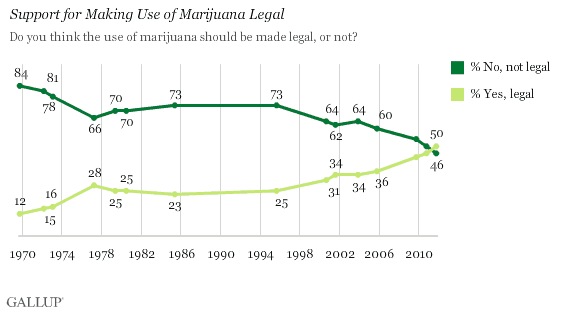A $200 transaction can cost society $100,000 for a three-year sentence.It’s time to legalize, regulate, and tax drugs, taking tax money away from private prisons and police militarization, and freeing it up for education, health care, and rehabilitation.
George F. Will wrote 11 April 2012, Should the U.S. legalize hard drugs?
Amelioration of today’s drug problem requires Americans toWill-like, he ignores the real reasons we’re locking up so many people (corporate greed), but he does get at the consequences:understand the significance of the 80-20 ratio. Twenty percent of American drinkers consume 80 percent of the alcohol sold here. The same 80-20 split obtains among users of illicit drugs.
About 3 million people — less than 1 percent of America’s population — consume 80 percent of illegal hard drugs. Drug-trafficking organizations can be most efficiently injured by changing the behavior of the 20 percent of heavy users, and we are learning how to do so. Reducing consumption by the 80 percent of casual users will not substantially reduce the northward flow of drugs or the southward flow of money.
More Americans are imprisoned for drug offenses or drug-related probation and parole violations than for property crimes. And although America spends five times more jailing drug dealers than it did 30 years ago, the prices of cocaine and heroin are 80 to 90 percent lower than 30 years ago.Which means a very few big drug dealers are rolling in cash, and a lot more “law enforcement” companies are laughing all the way to the bank at we the taxpayers’ expense.In “Drugs and Drug Policy: What Everyone Needs to Know,”
policy analysts Mark Kleiman, Jonathan Caulkins and Angela Hawken argue that imprisoning low-ranking street-corner dealers is pointless: A $200 transaction can cost society $100,000 for a three-year sentence. And imprisoning large numbers of dealers produces an army of people who, emerging from prison with blighted employment prospects, can only deal drugs. Which is why, although a few years ago Washington, D.C., dealers earned an average of $30 an hour, today they earn less than the federal minimum wage ($7.25).
Dealers, a.k.a. “pushers,” have almost nothing to do with initiating drug use by future addicts; almost every user starts when given drugs by a friend, sibling or acquaintance. There is a staggering disparity between the trivial sums earned by dealers who connect the cartels to the cartels’ customers and the huge sums trying to slow the flow of drugs to those street-level dealers. Kleiman, Caulkins and Hawken say that, in developed nations, cocaine sells for about $3,000 per ounce — almost twice the price of gold. And the supply of cocaine, unlike that of gold, can be cheaply and quickly expanded. But in the countries where cocaine and heroin are produced, they sell for about 1 percent of their retail price in the United States. If cocaine were legalized, a $2,000 kilogram could be FedExed from Colombia for less than $50 and sold profitably here for a small markup from its price in Colombia, and a $5 rock of crack might cost 25 cents. Criminalization drives the cost of the smuggled kilogram in the United States up to $20,000. But then it retails for more than $100,000.
Kleiman, Caulkins and Hawken urge rethinking the drug-control triad of enforcement, prevention and treatment because we have been much too optimistic about all three.Of both the illegal (drug cartel) and legal (drug interdiction product companies and misdirected LEO raids) kind.And cartels have oceans of money for corrupting enforcement because drugs are so cheap to produce and easy to renew. So it is not unreasonable to consider modifying a policy that gives hundreds of billions of dollars a year to violent organized crime.
Still think legalizing marijuana would be enough?
Marijuana probably provides less than 25 percent of the cartels’ revenue. Legalizing it would take perhaps $10 billion from some bad and violent people, but the cartels would still make much more money from cocaine, heroin and methamphetamines than they would lose from marijuana legalization.Sixteen states and the District have legalized “medical marijuana,” a messy, mendacious semi-legalization that breeds cynicism regarding law. In 1990, 24 percent of Americans supported full legalization. Today, 50 percent do. In 2010, in California, where one-eighth of Americans live, 46 percent of voters supported legalization, and some opponents were marijuana growers who like the profits they make from prohibition of their product.
Would the public health problems resulting from legalization be a price worth paying for injuring the cartels and reducing the costs of enforcement? We probably are going to find out.
 We already know the answer, because
Portugal already did it, and saw drug addiction decline,
along with law enforcement and health care costs.
We already know the answer, because
Portugal already did it, and saw drug addiction decline,
along with law enforcement and health care costs.
Here at home it would
end the failed War on Drugs,
worldwide it would
reduce pesticide spraying and pollution,
and it would
 cut the profits of the private prison industry (CCA’s own 2010 SEC report says so).
And it would
remove a major
excuse for the militarization of local police forces.
A majority of the American people already want
marijuana legalized.
cut the profits of the private prison industry (CCA’s own 2010 SEC report says so).
And it would
remove a major
excuse for the militarization of local police forces.
A majority of the American people already want
marijuana legalized.
It’s time for the land of the free and the home of the brave to follow Portugal’s lead by going beyond “a messy, mendacious semi-legalization”: legalize, regulate, and tax all drugs.
-jsq
Short Link: